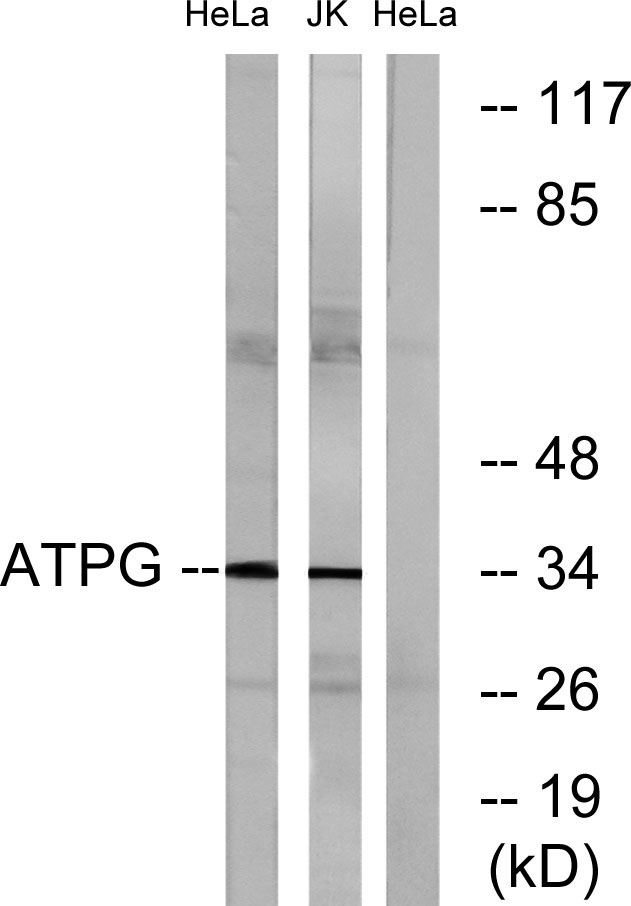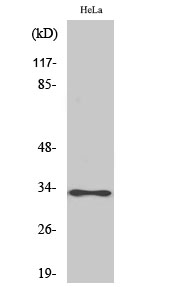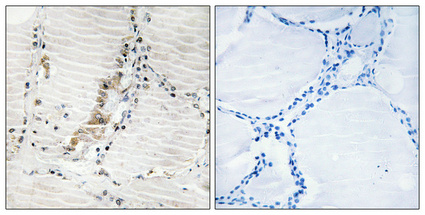产品名称
ATP5C1 Rabbit Polyclonal Antibody
别名
ATP5C1; ATP5C; ATP5CL1; ATP synthase subunit gamma; mitochondrial; F-ATPase gamma subunit
蛋白名称
ATP synthase subunit gamma mitochondrial
存储缓冲液
Liquid in PBS containing 50% glycerol, 0.5% BSA and 0.02% New type preservative N.
Human Gene Link
http://www.ncbi.nlm.nih.gov/sites/entrez?db=gene&term=509
Human Swissprot No.
P36542
Human Swissprot Link
http://www.uniprot.org/uniprotkb/P36542/entry
Mouse Gene Link
http://www.ncbi.nlm.nih.gov/sites/entrez?db=gene&term=11949
Mouse Swissprot No.
Q91VR2
Mouse Swissprot Link
http://www.uniprot.org/uniprot/Q91VR2
Rat Swissprot Link
http://www.uniprot.org/uniprot/P35435
免疫原
The antiserum was produced against synthesized peptide derived from human ATP5C1. AA range:131-180
特异性
ATP5C1 Polyclonal Antibody detects endogenous levels of ATP5C1 protein.
稀释度
WB 1:500 - 1:2000. IHC 1:100 - 1:300. ELISA: 1:40000.. IF 1:50-200
宿主
Polyclonal, Rabbit,IgG
背景介绍
This gene encodes a subunit of mitochondrial ATP synthase. Mitochondrial ATP synthase catalyzes ATP synthesis, utilizing an electrochemical gradient of protons across the inner membrane during oxidative phosphorylation. ATP synthase is composed of two linked multi-subunit complexes: the soluble catalytic core, F1, and the membrane-spanning component, Fo, comprising the proton channel. The catalytic portion of mitochondrial ATP synthase consists of 5 different subunits (alpha, beta, gamma, delta, and epsilon) assembled with a stoichiometry of 3 alpha, 3 beta, and a single representative of the other 3. The proton channel consists of three main subunits (a, b, c). This gene encodes the gamma subunit of the catalytic core. Alternatively spliced transcript variants encoding different isoforms have been identified. This gene also has a pseudogene on
组织表达
Isoform Heart is expressed specifically in the heart and skeletal muscle, which require rapid energy supply. Isoform Liver is expressed in the brain, liver and kidney. Isoform Heart and Isoform Liver are expressed in the skin, intestine, stomach and aorta.
细胞定位
Mitochondrion inner membrane ; Peripheral membrane protein ; Matrix side .
信号通路
Oxidative phosphorylation;Alzheimer's disease;Parkinson's disease;Huntington's disease;
功能
function:Mitochondrial membrane ATP synthase (F(1)F(0) ATP synthase or Complex V) produces ATP from ADP in the presence of a proton gradient across the membrane which is generated by electron transport complexes of the respiratory chain. F-type ATPases consist of two structural domains, F(1) - containing the extramembraneous catalytic core, and F(0) - containing the membrane proton channel, linked together by a central stalk and a peripheral stalk. During catalysis, ATP synthesis in the catalytic domain of F(1) is coupled via a rotary mechanism of the central stalk subunits to proton translocation. Part of the complex F(1) domain and the central stalk which is part of the complex rotary element. The gamma subunit protrudes into the catalytic domain formed of alpha(3)beta(3). Rotation of the central stalk against the surrounding alpha(3)beta(3) subunits leads to hydrolysis of ATP in three separate catalytic sites on the beta subunits.,function:Produces ATP from ADP in the presence of a proton gradient across the membrane. The gamma chain is believed to be important in regulating ATPase activity and the flow of protons through the CF(0) complex.,similarity:Belongs to the ATPase gamma chain family.,subunit:F-type ATPases have 2 components, CF(1) - the catalytic core - and CF(0) - the membrane proton channel. CF(1) has five subunits: alpha(3), beta(3), gamma(1), delta(1), epsilon(1). CF(0) has three main subunits: a, b and c.,tissue specificity:Isoform H is expressed specifically in the heart and skeletal muscle, which require rapid energy supply. Isoform L type is expressed in the brain, liver, kidney. Both forms are expressed in the skin, intestine, stomach, and aorta.,
纯化
The antibody was affinity-purified from rabbit antiserum by affinity-chromatography using epitope-specific immunogen.



